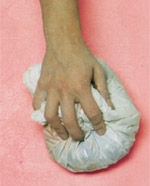|
|

|
|

Wall Paint Effects |
Rags |
Brush |
Bag |
Sponge |
Stencils |
Dragging a brush over a freshly
painted surface, is a popular effect for
woodwork as well as walls. Latex or semi gloss enamel can be used on walls, semi gloss only
on woodwork. This effect requires two people working together. You need two
brushes, one for painting and the other for dragging off the paint. Dragging
brush, should be a long bristled wide brush.
well as walls. Latex or semi gloss enamel can be used on walls, semi gloss only
on woodwork. This effect requires two people working together. You need two
brushes, one for painting and the other for dragging off the paint. Dragging
brush, should be a long bristled wide brush.
Dragging effect is created by painting a thin glaze of colour over a base coat then using a dry brush to drag off this colour, allowing the base colour to be seen through in between. The result is finely marked off lines. They can be dragged vertically or horizontally, even one on the top of the other.
Dilute the colour to be dragged at least 50:50. Mix enough to drag a complete wall. The paint is applied thinly and evenly in strips about 2ft wide, to completely cover the base coat. One person brushes on the colour, the second person drags it off while it is still wet.
Hold the dragging brush (long-bristled wide brush) firmly and draw it steadily down through the wet paint. Wipe the brush on rags after two or three strokes so that it does not become so loaded with paint that it puts it on rather than takes it off. Relax the grip at the end of a stroke - at the bottom of the wall, round light switches and other obstacles as this is where paint tends to build up.
The edge of each strip of paint being brushed on must remain wet if the strip next to it is to merge properly. Any build up of drying paint between strips will be obvious and will ruin the delicate effect. The painter should start applying the second strip while the dragger works on the first, the dragger follows the painter along the wall.
This light effect is created by
pressing a light weight plastic bag half filled with rags (tied together by a
knot) on a freshly painted wall. It requires two colours, preferably related
pastel shades and two people working together. 
Base coat : Apply a base coat of thin latex paint with a light shade of your choice. Use a 4 to 6 inches wide brush. Start with horizontal strokes from the top of the wall in a specific area and cover with vertical strokes before the paint dries to give a good finish. Repeat the process until the whole wall is painted. Allow the base coat to dry.
Dilute the graining paint (latex or enamel) 50:50, if latex with water and if gloss enamel, with white spirit. A sufficient quantity must always be mixed to finish a whole wall. Paint on the diluted graining coat, in strips about 2ft wide, thinly and evenly to cover the base coat. Hold the bag, the knot nearest to the palm. Press the bag onto the painted surface, lift and repeat in an adjoining area, before the paint dries. Overlap the bag impressions slightly to create the crushed and crinkled impression. Wipe excess paint off the bag in between.
One person can paint on the graining coat and the other can do the effect part. When the painter finishes the top half of the strip of paint the other can immediately start pressing the bag on the top half while the painter works on the bottom half.
This method is used for creating a speckled effect with two or more colours. The base coat of colour is applied to the entire surface and the other colours are dabbed on to it, using a natural sponge.
Base coat : Apply a base coat of either thin latex or semi gloss. Use a 4 to 6 inches wide brush. Start with horizontal strokes from the top of the wall in a specific area and cover with vertical strokes before the paint dries to give a good finish. Repeat the process until the whole wall is painted. Allow the base coat to dry for 24hours.
The paint to be sponged on can be used as it is or thinned for a more delicate, semi-transparent effect. Dilute the colour to be sponged, if latex with water and if semi gloss with white spirit at 50:50. If preferred more thinner can be added.
Take a little of the paint diluted into a bowl. Dampen the sponge with water and squeeze it out. Press the flat side into the paint to absorb most of it. The effect created can be tested on a piece of lining paper by pressing the sponge on it. If you are satisfied with the result you can start working on the prepared wall. while working on the wall, be careful not to skid across the surface. The speckled look will lessen as the paint runs out. Refill the sponge with paint, test as before and continue. When the wall is finished, leave the sponged on colour to dry for 24 hours. If desired, a second colour can be sponged on in exactly the same way in between the gaps left by the first sponging, slightly overlapping to create a random effect.
If you feel that too much colour has been sponged on, sponge on some more base colour to lighten the effect.